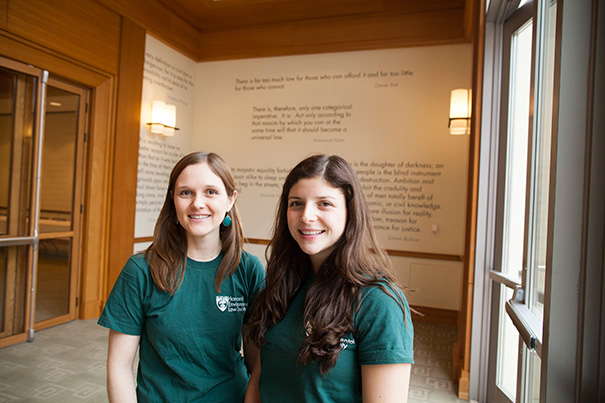
Harvard Environmental Law Society co-presidents Genevieve Parshalle ’15 (left) and Cecilia Segal ’15 curated the framework of the National Association of Environmental Law Societies Conference around environmental justice, which, said Segal, “is more interdisciplinary and touches on things like social justice, civil rights.”
Stephanie Mitchell/Harvard Staff Photographer
A range of voices on environmental justice
HLS students bring broad vision to conference
In 1994, Richard Lazarus was named to the Environmental Protection Agency’s newly created federal advisory committee on environmental justice. Among its responsibilities: helping implement President Bill Clinton’s executive order on environmental justice. But the task force’s first act, recalled the Howard and Katherine Aibel Professor of Law, amounted to a coup.
Then-EPA chief Carol Browner????s decision to have the head of a state agency lead the group was “a major misstep” said Lazarus, and the committee promptly rejected her choice. “You don’t put the head of a state agency in charge of anything to do with environmental justice.”
The rebuff highlighted a glaring disconnect within the environmental justice movement at the time, Lazarus said. “The whole problem was that mainstream environmental groups and agencies had not been paying attention to the needs and distinct interests, from the environmental protection perspective, of low-income communities and communities of color in the United States.”
When the student-led Harvard Environmental Law Society (HELS) hosts the 26th annual National Association of Environmental Law Societies Conference Friday and Saturday at HLS, decision-makers representing a range of sectors in the environmental justice movement will be part of the discussion. In recognition of the 20th anniversary of Clinton’s executive order, the two-day event will explore the current environmental justice landscape, as well as strategies to uphold environmental law as a national priority.
“Unlike the EPA back in the 1990s, the students got it,” said Lazarus who praised the conference planners for bringing together community organizers with “people who have been major players and inspirational leaders in this area from all walks.”
“This is not just something where there are going to be a bunch of national leaders who run the show. It is all about community empowerment.”
In preparing to bid for the national conference, a team of students led by HELS co-presidents Genevieve Parshalle ’15 and Cecilia Segal ’15 considered a framework built around a hot-button issue such as climate change or hydraulic fracking. They opted instead for a subject they think has received less attention, but could “gain traction” with other students.
“Environmental justice is more interdisciplinary and touches on things like social justice, civil rights,” said Segal. “A lot of people are passionate about those topics and we realized we would get a much broader appeal with a topic like this; this is actually more about humans affected on a daily basis.”
Among the roughly 200 attendees will be social scientists, lawyers, community organizers, representatives from state and federal agencies, grass-roots activists, and students.
“I am thrilled to be attending Harvard Law School’s Environmental Justice Conference,” said Curt Spalding, regional administrator for EPA New England. “Environmental justice is such an important topic, one that is in fact critical to EPA’s mission.”
The first day of the conference will explore the roots of the environmental justice movement and include a talk by Texas Southern University’s Robert Bullard, whom many consider the father of the environmental justice movement. Lisa Jackson, former EPA head and now vice president of environmental initiatives at Apple, will also speak.
On Saturday, the discussion will turn to specific issues of food justice, urban environmental justice, and access to clean energy. The event will conclude with a series of informal discussion sessions with Spalding and representatives from other federal agencies. Organizers plan to blog about the conference for the EPA’s website.
“I think it is just an amazing opportunity to see what happens when you get all these people together with the express purpose of thinking about what’s worked, what hasn’t worked, and how can we move forward on this topic,” said Parshalle. “It will be really exciting to see what suggestions come out of it, and to see if we can really help move the conversation forward.”
Harvard is emerging as a national presence in environmental law, said Lazarus. In 2005, the School hired Jody Freeman, a leading scholar in administrative and environmental law, to launch its environmental law program. Today the program includes a clinic and the Environmental Policy Initiative, a resource for federal and state officials.
“It would have been unimaginable anytime before now since 1970 to have Harvard host this meeting,” said Lazarus. “But the fact we are really is a statement about where the program has come.”
Both the Law School’s commitment to the issue and the students involved in the environmental program were critical in securing the conference, he added.
“The students are extraordinary. They put in the bid. They came up with the environmental justice theme. They did it. … It’s a wonderfully, sensitively constructed program.”
Asked about the status of environmental justice 20 years after Clinton’s order, Lazarus said, “In the mid-’90s there was a tremendous sense that we were going to see a sea change in the ways that environmental laws were administered and enforced. I think that those very optimistic sentiments have been realized, but only in part.”
To learn more about the conference, visit the NAELS 2014 website.




